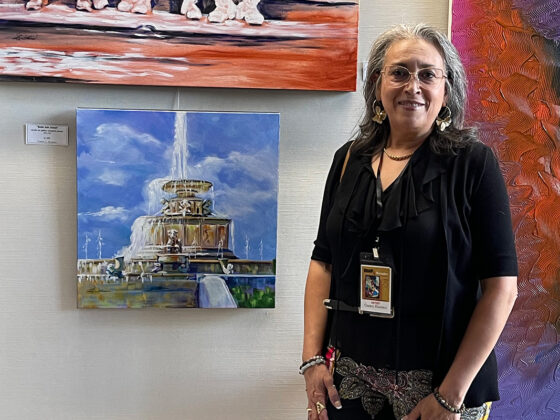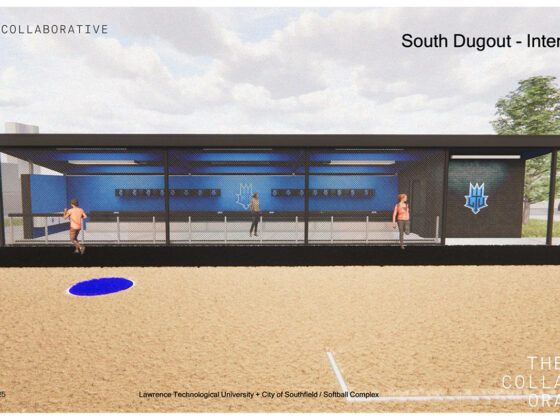Designs may bridge community, school life
From the South Oakland Eccentric
By Sandra Armbruster
As the saying goes, if you build it, they will come. But instead of a baseball field, in this case, five students at Lawrence Technological University in Southfield are talking about an area known to city of Southfield officials as the City Centre.
Generally speaking, that area is centered at Evergreen Road and Civic Center Drive, across from the Civic Center. It is filled with tall office buildings, a historic farm and, as it turns out, a lot of students from LTU and other universities and colleges in the area.
LTU students — including Mike Knoff, Erik Slagter, Deanna Hewitt, Abby Schroeder and Gena Briolat — are “always building stuff,” as Knoff put it. So faced with what they believe are things left wanting in the city’s central area, they devised a design competition.
They like the $5 burger nights at McVee’s on Telegraph, but their eyes turned toward Evergreen.
The students are quite familiar with the Evergreen corridor, between 11 Mile and 10 Mile roads. Evergreen has a little “slice of everything,” they say as they enumerate all the different ethnic restaurants located in strip centers in that area. The offerings range from Biggby coffee to cupcake shops, as well as Tim Horton’s (Canadian, say the students) and a Thai restaurant.
What’s needed
But the students have done a lot of thinking about the area and figured it needs a restaurant that could be enjoyed by students and families during the day that could easily morph into a night spot for the community which, of course, would still include students.
Combining that thinking with a vacant storefront that used to be a printing business on Evergreen, just north of 10 Mile, the students had the elements for a hotly contested design competition.
For guidance, they contacted Phil Lucas, student government president, as well as Terry Croad, Southfield city planner, and Hassan Jamad, a developer along Evergreen. The objective was to come up with a usable design for everything from the menu to the logo for a place that would be “like the bar in Cheers or the cafe in Friends.” It was to be a comfortable and public third place, as the students described it, outside of where they live and attend class. And someplace that would attract different people at different times of the day, Hewitt explained.
“There’s no lounge space off-campus,” Slagter said.
Knoff said that the students expected four or five entries. They got 12, but that wasn’t the end of it. The designs, placed on detailed boards made with computer software, were displayed at LTU so students could vote on which entries they liked best in five categories.
The displays caught the interest of students, who cast a total of 400 votes for their favorite designs. Knoff let out a breath as he recalled the job of counting all 400 ballots.
“Overall, it was a lot bigger success” than they expected, he said.
But the student votes counted for only 25 percent of the eventual score for each project in the four categories in the competition — Best Atmosphere, Best Logo and Branding, Best Menu and Best Overall Design. A jury with five judges did the rest, including judging a presentation by the top entries.
The challenge
The special challenge for students was that the interior space they had to work with was 1,200 square feet, but Croad allowed students in the competition to devise a green space for expanded seating.
Briolat and Schroeder won in the category of Best Interior Design. Schroeder said they employed durable but modern materials in their design that would allow “flexibility of uses … (that would) bridge the gap between the community and the school.”
Knoff and Hewitt won the competition for Best Menu, calling for “handwiches,” sandwiches that it would take two hands to get around, in addition to build-your-own pizza and burgers. They called the place the Pint and Pitchfork, which they said was a play on the LTU sports mascot.
Slagter, who won for Best Logo and Branding, went in a different direction after doing considerable research with everything from yearbooks to information about the Henry Ford building in Highland Park. The result, he said, “reflects the spirit of LTU of the past.” He even chose music for the venue, which he said was a mix of modern and vintage.
With the competition over, the students have other concerns besides designing a place to gather. Those include getting to Evergreen. The area needs to be safer for walking purposes, Slagter said.
“The 10 Mile Road bridge (over Northwestern Highway) is scary,” he said. “It wasn’t made for walking, and the expressway is right below. The Civic Center bridge has a bike path.”
But they are already looking toward what they hope will be the next step. Knoff said they will work in collaboration with Croad and Jamad, and LTU business students will be brought in to develop a business plan.
The students say they are proud of their work. Hopefully, the zoning will be changed, Knoff said, “and a lot more.”





